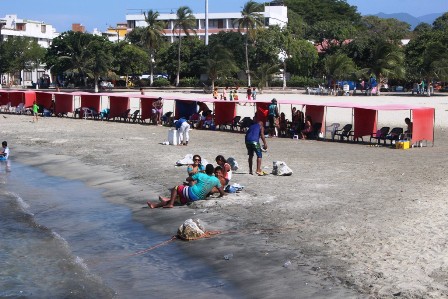
Click the photo above to see a Santa Marta album. Close the window to return.
Read Previous Episode: Cartagena or Next Episode: Casa Barlovento
January 9-11 and January 14 2016
Santa Marta is the kind of town that grows on you. It doesn’t have UNESCO rating or the number of beautiful Colonial mansions and churches that Cartagena or Bogota have, but it is a more relaxing town and it has the best restaurants we encountered so far.
It took four hours on flat, well-paved roads along the cost in a comfortable MarSol minivan to reach Santa Marta from Cartagena. I read a book most of the way. That was the last good road we encountered for the next week. Our room in Hostel Color was quiet and comfortable, the breakfast was good, the staff was pleasant, and it was a 15 minute walk to see the sights of town. What more could we want.
There is a long beach across the front of town that is popular for a day outing with locals, who rent shade shelters and bring a lunch and buy drinks and snacks from the beach side vendors. The swimming did not appeal to me because it was too close to the main harbour that accommodated freighters and cruise ships making their second stop, after Cartagena, in Colombia. We were content to walk the beach promenade and watch the boats and swimmers.
The Gold Museum, in a Colonial mansion previously used as the Customs House, was worth a visit. The relatively small, but good collection of gold artifacts took second place to the history of the area. We enjoyed the displays and information about the indigenous Tayrona people who lived in the area before the Spanish Conquistadors arrived. The displays were informative and well designed. Santa Marta was founded in 1525 as a port from which all the gold plundered from the Tayronas was shipped back to Spain. Santa Marta was also a gateway to the interior, from which the Spanish set off up the Magdalena Valley to found Bogota in 1538.
Both lunch and night time brought out the diners to
restaurants near Los Novios Park. We enjoyed some of our best meals there. Lulo,
which is named for a fruit similar to a persimmon but with multiple seeds, was
our favourite lunch charge and Ouzo, a Greek fusion restaurant, was the
restaurant where we indulged in seafood for dinner. It was fun enjoying our meal
and taking in the street buskers who appeared to play instruments, dance the
tango, or break dance in the park band shell.
We sampled a typical Colombian treat for the first time. We had passed a road side BBQ cooking up fat pancakes, called Arepas. We ordered one to be shared by the two of us one night. It is rich mixture of corn meal and cheese. The evening version, baked over coals by two women was thick and very rich. We later ordered a lighter version with breakfast, as a choice rather than white bread toast. The only thing missing for us was a salsa or syrup to put on the arepas.
A great favourite of locals coming to the beach is a dish from the simple road side stand called Cocteleria Juancho, whose most popular dish is ceviche. We searched for it one night and found a line-up of 50 people waiting to place their orders. Luckily, we had spied a new branch of the restaurant a block away on the ground floor of a new apartment building. We found the ceviche just as good as the reports had promised. Judging by the number of locals who were enjoying the new branch with us, the owners were right to establish an additional outlet.
|
Return to Columbia Intro
Return to Travels
Return to Introduction